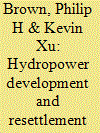| Srl | Item |
| 1 |
ID:
098106


|
|
|
|
|
| Publication |
2010.
|
| Summary/Abstract |
Hydropower represents an important alternative form of energy in China, a country that currently uses coal to supply 78% of its electricity. However, evidence from large hydropower projects in China shows that the socio-economic and environmental costs of hydropower development are substantial. Construction on the first of the 13 planned dams on the Nu River began in the summer of 2008, and villages are already beginning to be displaced. Based on fieldwork in the area, we find that the local resettlement policies infringe upon the national regulations governing resettlement caused by major infrastructure development. This infringement includes high prices for resettlement homes, forcing villagers to leave agricultural production, a lack of programs for long-term economic development, and a lack of transparency in decision-making processes.
|
|
|
|
|
|
|
|
|
|
|
|
|
|
|
|
| 2 |
ID:
089767


|
|
|
|
|
| Publication |
2009.
|
| Summary/Abstract |
Although the New Co-operative Medical System (NCMS) was expected to operate in all rural Chinese counties by the end of 2008, county governments were given significant leeway in the design of the local programmes. As a result, fundamental characteristics of NCMS programmes vary dramatically between counties. Such heterogeneity in programme design may influence satisfaction with the NCMS in each county, and thus each programme's prospects for success. This article uses survey data collected by the authors to consider five distinct measures of success. We find that households respond favourably to making emigrants eligible for coverage and to lowering the spending threshold for reimbursement eligibility. However, households are less likely to have received reimbursement in counties that require referrals or limit treatment to approved hospitals. Finally, out-of-pocket expenditures associated with catastrophic health care may still be too high to facilitate treatment of the rural poor.
|
|
|
|
|
|
|
|
|
|
|
|
|
|
|
|